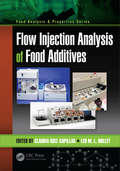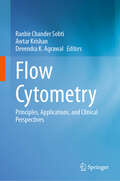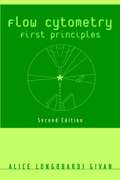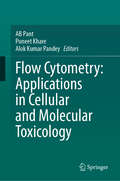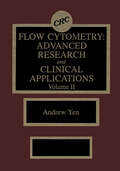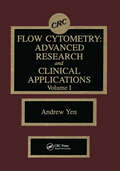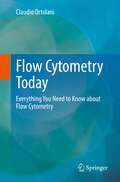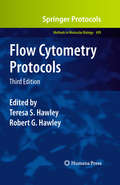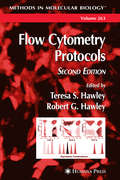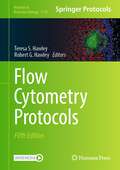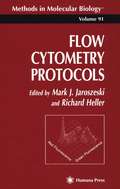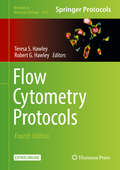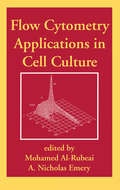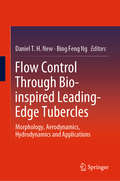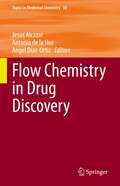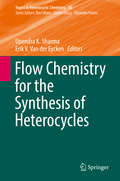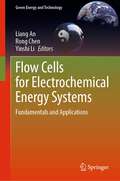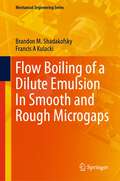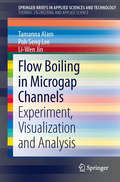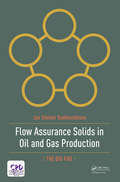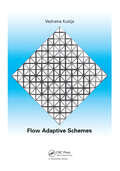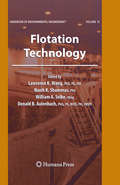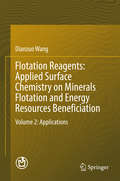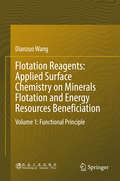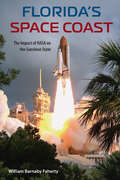- Table View
- List View
Flow Injection Analysis of Food Additives (Food Analysis & Properties)
by Leo M. L. NolletFlow Injection Analysis of Food Additives gives you the tools you need to analyze food and beverage additives using FIA. This sets it apart from other books that simply focus on the theoretical basis and principles of FIA or on the design of equipment, instrumentation, manifold, and setting mechanism. Truly unprecedented in its scope, this book rep
Flow Cytometry: Principles, Applications, and Clinical Perspectives
by Awtar Krishan Ranbir Chander Sobti Devendra K. AgrawalFlow cytometry is a state-of-the-art technology that is widely used in biological research and clinical diagnostics. It is a high-throughput platform that allows the quantification, differentiation, and functional study of cells or cell like particles in suspension. Various cell components can be targeted with fluorescently labelled antibodies or fluorescent dyes to allow measurement and analysis of the physical, chemical, and biological properties of individual cells within homogenous or heterogeneous populations. Since its commercialization more than five decades ago, flow cytometry has advanced and become an very important analytical tool in translational research. With the advancement of instrument technology, an increasing number of fluorescent dyes, and an expanding range of monoclonal antibodies, the applications of flow cytometry in applied research continue to grow. The use of multiparametric flow cytometry in translational research provides the ability to rapidly identify different cell populations and to simultaneously measure multiple parameters of single cells for efficiently assessing immune status, decrease/increase of specific immune cell populations, cell activation status, etc. of different cells in preclinical and clinical studies. The primary goal of any research work is to take research results from the "bench to-bed and back". The use of flow cytometry in applied research advances the development of new diagnostic tests or drugs for cancer treatment, immune monitoring, etc. that help in patient care. Today, every biological scientist needs to have basic knowledge of flow cytometry in order to utilise this technology properly in their own research and to understand other’s research work. The present book has been designed to give the knowledge of flow cytometry and its applications to the researchers and teachers. It will allow the readers to utilize the technology in an appropriate way in their research work. This book has describing various applications of flow cytometry like cell health monitoring, immunophenotyping, cell sorting, stem cell characterization, micro-vesicle analysis etc.
Flow Cytometry: First Principles
by Alice Longobardi GivanFlow cytometry continually amazes scientists with its ever-expanding utility. Advances in flow cytometry have opened new directions in theoretical science, clinical diagnosis, and medical practice. The new edition of Flow Cytometry: First Principles provides a thorough update of this now classic text, reflecting innovations in the field while outlining the fundamental elements of instrumentation, sample preparation, and data analysis. Flow Cytometry: First Principles, Second Edition explains the basic principles of flow cytometry, surveying its primary scientific and clinical applications and highlighting state-of-the-art techniques at the frontiers of research. This edition contains extensive revisions of all chapters, including new discussions on fluorochrome and laser options for multicolor analysis, an additionalsection on apoptosis in the chapter on DNA, and new chapters onintracellular protein staining and cell sorting, including high-speed sorting and alternative sorting methods, as well as traditional technology. This essential resource: Assumes no prior knowledge of flow cytometry Progresses with an informal, engaging lecture style from simpleto more complex concepts Offers a clear introduction to new vocabulary, principles of instrumentation, and strategies for data analysis Emphasizes the theory relevant to all flow cytometry, with examples from a variety of clinical and scientific fields Flow Cytometry: First Principles, Second Edition provides scientists, clinicians, technologists, and students with the knowledge necessary for beginning the practice of flow cytometry and for understanding related literature.
Flow Cytometry: Applications in Cellular and Molecular Toxicology
by Ab Pant Puneet Khare Alok Kumar PandeyThe book explores the role of flow cytometry in varied fields, from clinical diagnosis to toxicology. This comprehensive book offers insights into biomarkers, cellular analysis, and safety evaluations. Organized into fifteen chapters, this book explores flowcytometry's historical journey, scientific validation, and implementation in toxicity studies with case studies, technical and applied approaches, pictorial representations, informative tables, and simple language, It will be an invaluable resource for researchers, academia, biopharma industries, graduate and postgraduate students, Ph.D., and post-doctoral fellows working in the fields of toxicology/biosafety, and biomedical research.
Flow Cytometry: Advanced Research and Clinical Applications, Volume II
by Andrew YenThe current technology and its applications in flow cytometry are presented in this comprehensive reference work. Described in explicit detail are the instrumentation and its components, and applications of the technology in cell biology, immunology, pharmacology, genetics, hematology and clinical medicine. Methods for data analysis, including both hardware and software, and explicit experimental techniques for making specific measurements are presented.Material is divided by topic into two volumes: Volume I covers instrumentation, genetics, and cell structure; Volume II contains material on cell function studies by flow cytometry.This reference is essential for both the novice and the experienced investigator using flow cytometry in research, and for students of cell biology, biomedical engineering, and medical technology.
Flow Cytometry: Advanced Research and Clinical Applications, Volume I
by Andrew YenThe current technology and its applications in flow cytometry are presented in this comprehensive reference work. Described in explicit detail are the instrumentation and its components, and applications of the technology in cell biology, immunology, pharmacology, genetics, hematology and clinical medicine. Methods for data analysis, including both hardware and software, and explicit experimental techniques for making specific measurements are presented.Material is divided by topic into two volumes: Volume I covers instrumentation, genetics, and cell structure; Volume II contains material on cell function studies by flow cytometry.This reference is essential for both the novice and the experienced investigator using flow cytometry in research, and for students of cell biology, biomedical engineering, and medical technology.
Flow Cytometry Today: Everything You Need to Know about Flow Cytometry
by Claudio OrtolaniThis book covers all the technical aspects of flow cytometry needed to set-up the instrument, solve problems encountered in daily work, or necessary for exam preparation. It provides the reader with an in-depth look at the device and its applications. Each component and its function is described in an easy-to-understand manner, giving the reader a sound basic knowledge of this instrument. The practical examples given, simplify and enhance the learning process. This book is a unique resource of knowledge for biomedical engineers and biotechnologists, flow cytometry operators, laboratory technicians and biomedical researchers, both biologists as well as medical doctors, and can also be a helpful tool for companies and manufacturers.
Flow Cytometry Protocols, 3rd Edition
by Robert G. Hawley Teresa S. HawleyWith rapid improvements in instrumentation, lasers, fluorophores, and data analysis software, flow cytometry is riding the crest of unprecedented, innovative advances. This thoroughly revised and up-to-date third edition of Flow Cytometry Protocols highlights the expanding contribution of flow cytometry to basic biological research and diagnostic medicine. Written by leading experts in the field, the book presents cutting-edge topics such as polychromatic, quantitative, and high throughput flow cytometry, novel multiparametric data analysis which breaks the dimensionality barrier, standard practice and safety measures for aerosol-generating cell sorting, conventional and imaging flow cytometry as well as minimalist imaging cytometry. As a volume in the highly successful Methods in Molecular Biology™ series, chapters contain brief introductions to their respective topics, lists of the necessary materials and reagents, step-by-step, readily reproducible laboratory protocols, and extensive notes on troubleshooting and avoiding known pitfalls. Authoritative and comprehensive, Flow Cytometry Protocols, Third Edition presents established as well as new flow cytometric methodologies in order to introduce beginning users to basic applications while opening new avenues of innovation for seasoned users.
Flow Cytometry Protocols, 2nd Edition
by Robert G. Hawley Teresa S. HawleyThis thoroughly revised and updated edition of a widely used practical guide to flow cytometry describes in step-by-step detail an array of time proven and cutting-edge techniques much needed in today's advanced laboratories. These readily reproducible methods deploy emerging flow cytometry technologies in many new applications, especially in the field of stem cells, functional genomics and proteomics, and microbiology. Here, the aspiring investigator will find methods for the characterization of stem/progenitor cells by monitoring the efflux of fluorescent dyes and the elucidation of signal transduction pathways using phospho-specific antibodies. There are also techniques for monitoring gene transfer and expression using fluorescent protein technology, high throughput screening for discovery of novel protein interactions, phenotypic and functional characterization of T cell subsets and precursors, and microbial flow cytometry, to highlight but some of the many useful procedures.
Flow Cytometry Protocols (Methods in Molecular Biology #2779)
by Robert G. Hawley Teresa S. HawleyThis fifth edition volume expands on the previous editions by presenting readers with the latest developments and emerging methodologies in cytometry. The chapters in this book cover cytometry basics such as lasers for cytometry, metrics that can be used to evaluate spillover spreading, and the process of panel design and iterative optimization for spectral flow cytometry; novel methodologies such as image-enabled cell sorting, co-staining of fluorochrome-conjugated and oligonucleotide-conjugated antibodies, and screening for cell type selective probes; and a look at the achievements made in the clinical setting for both flow and mass cytometry. Written in the highly successful Methods in Molecular Biology series format, chapters include introductions to their respective topics, lists of the necessary materials and reagents, readily reproducible step-by-step laboratory protocols, and tips on troubleshooting and avoiding known pitfalls.Cutting-edge and comprehensive, Flow Cytometry Protocols, Fifth Edition is a valuable resource for researchers and scientists who are interested in continuing or expanding their knowledge of this developing field.
Flow Cytometry Protocols
by Richard Heller Mark J. JaroszeskiIn addition to providing chapters on the theoretical and practical aspects of flow cytometry, this book contains protocols used specifically for immediate use in the diagnostic and experimental measurements enabled by modern flow cytometric instrumentation. Research protocols cover cell cycle analysis and regulation, detection of rare cells, solid tumor DNA techniques, ploidy analysis and the application of flow cytometric methods for measurements of leukemias, necrosis, apoptosis, heat shock proteins, liver and bladder cancer, disease monitoring, and intracellular measurements. Hematologic and immunologic applications are also described by researchers with a particular expertise in their use. A special section is included for biotechnologists using flow cytometry in the study of protein secretion, the monitoring of fermentation processes, monitoring bioreactors, cell-cell electroporation, quantitation electrofusion, and electrochemotherapy.
Flow Cytometry Protocols
by Robert G. Hawley Teresa S. HawleyFlow cytometry has evolved since the 1940s into a multidisciplinary field incorporating aspects of laser technology, fluid dynamics, electronics, optics, computer science, physics, chemistry, biology, and mathematics. Innovations in instrumentation, development of small lasers, discovery of new fluorochromes/fluorescent proteins, and implementation of novel methodologies have all contributed to the recent rapid expansion of flow cytometry applications. In this thoroughly revised and updated second edition of Flow Cytometry Protocols, time-proven as well as cutting-edge methods are clearly and comprehensively presented by leading experimentalists. In addition to being a valuable reference manual for experienced flow cytometrists, the editors expect this authoritative up-to-date collection to prove useful to investigators in all areas of the biological and biomedical sciences who are new to the subject. The introductory chapter provides an eloquent synopsis of the principles and diverse uses of flow cytometry, beginning with a historical perspective and ending with a view to the future. Chapters 2-22 contain step-by-step protocols of highly practical and state-of-the-art techniques. Detailed instructions and helpful tips on experimental design, as well as selection of reagents and data analysis tools, will allow researchers to readily carry out flow cytometric investigations ranging from traditional phenotypic characterizations to emerging genomics and proteomics applications. Complementing these instructive protocols is a chapter that provides a preview of the next generation of solid-state lasers, and one that describes a rapid means to validate containment of infectious aerosols generated during high-speed sorting (Chapters 23-24).
Flow Cytometry Applications in Cell Culture
by Mohamed Al-RubeaiThis work present practical, biotechnological applications of flow cytometry techniques for the study of animal, plant and microbial cells, explaining methodologies for sample preparation, staining and analysis. It discusses cell variability in cell culture processes and shows how the quantitative analysis of heterogeneous populations aids in the biotechnological exploitation of cells.
Flow Control Through Bio-inspired Leading-Edge Tubercles: Morphology, Aerodynamics, Hydrodynamics and Applications
by Daniel T. H. New Bing Feng NgThis book describes and explains the basis of bio-inspired, leading-edge tubercles based on humpback whale flippers as passive but effective flow control devices, as well as providing a comprehensive practical guide in their applications. It first discusses the morphology of the humpback whale flipper from a biological perspective, before presenting detailed experimental and numerical findings from past investigations by various experts on the benefits of leading-edge tubercles and their engineering implementations.Leading-edge tubercle designs and functions have attracted considerable interest from researchers in terms of understanding their role in the underwater agility of these whales, and to exploit their flow dynamics in the development of new and novel engineering solutions. Extensive research over the past recent years has demonstrated that the maneuverability of these whales is at least in part due to the leading-edge tubercles acting as passive flow control devices to delay stall and increase lift in the post-stall regime. In addition to the inherent benefits in terms of aerodynamics and hydrodynamics, investigations into leading-edge tubercles have also broadened into areas of noise attenuation, stability and industrial applications.This book touches upon these areas, with an emphasis upon the effects of lifting-surface types, flow regimes, tubercle geometries, lifting-surface stability and potential industrial applications, among others. As such, it features contributions from key experts in the fields of biology, physics and engineering who have conducted significant studies into understanding the various aspects of leading-edge tubercles. Given the broad coverage and in-depth analysis, this book will benefit academic researchers, practicing engineers and graduate students interested in tapping into such a unique but highly functional flow control strategy.
Flow Chemistry in Drug Discovery (Topics in Medicinal Chemistry #38)
by Antonio de la Hoz Jesus Alcazar Angel Díaz-OrtizThis book reviews the challenges and opportunities posed by flow chemistry in drug discovery, and offers a handy reference tool for medicinal chemists interested in the synthesis of biologically active compounds. Prepared by expert contributors, the respective chapters cover not only fundamental methodologies and reactions, such as the application of catalysis, especially biocatalysis and organocatalysis; and non-conventional activation techniques, from photochemistry to electrochemistry; but also the development of new process windows, processes and reactions in drug synthesis. Particular attention is given to automatization and library synthesis, which are of great importance in the pharmaceutical industry. Readers will also find coverage on selected topics of general interest, such as how flow chemistry is contributing to drug discovery R&D in developing countries, and the green character of this enabling technology, for example in the production of raw materials for the pharmaceutical industry from waste. Given its scope, the book appeals to medicinal chemistry researchers working in academia and industry alike, as well as professionals involved in scale-up and drug development.
Flow Chemistry for the Synthesis of Heterocycles (Topics in Heterocyclic Chemistry #56)
by Upendra K. Sharma Erik V. Van der EyckenThis volume provides an overview of recent developments and scope in the use of flow chemistry in relevance to heterocyclic synthesis. The heterocyclic ring is the most prominent structural motif in the vast majority of natural products as well as pharmaceutical compounds since this facilitates tuneable interactions with the biological target besides conferring a degree of structural and metabolic stability. In recent times, flow chemistry has heralded a paradigm shift in organic synthesis as it offers several unique advantages over conventional methods like drastic acceleration of sluggish transformations, enhanced yields, cleaner reactions etc and is gradually gaining a lot of attention among organic chemist worldwide. Given the importance of heterocycles in natural products, medicinal chemistry and pharmaceuticals, this is a well warranted volume and complements the previous volume of Topics in Organometallic Chemistry ‘Organometallic Flow Chemistry’. This volume offers a versatile overview of the topic, besides discussing the recent progress in the flourishing area of flow chemistry in relevance to heterocyclic chemistry; it will also help researchers to better understand the chemistry behind these reactions. This in turn provides a platform for future innovations towards the designing of novel transformations under continuous flow. Thus, this volume will appeal to both the novices in this field as well as to experts in academia and industry.
Flow Cells for Electrochemical Energy Systems: Fundamentals and Applications (Green Energy and Technology)
by Liang An Rong Chen Yinshi LiThis book is a state-of-the-art review on recent advances in flow cells for electrochemical energy systems. The book includes an introduction to flow cells, proton exchange membrane fuel cells, photocatalytic fuel cells, organic flow batteries, redox flow batteries, microfluidic flow cells, as well as electrolysis cells for CO2 and nitrogen reduction. The book provides an essential reference for professors, researchers, and policymakers globally in academia, industry, and government.
Flow Boiling of a Dilute Emulsion In Smooth and Rough Microgaps (Mechanical Engineering Series)
by Brandon M. Shadakofsky Francis A KulackiThis book elucidates heat transfer behavior for boiling of dilute emulsions- mixtures of two immiscible fluids- which has received little attention to date. Of the work completed in this area, the majority has been focused on pool boiling where no mean flow is present, and this book is the first major work to be published regarding flow boiling of emulsions. The book includes a comprehensive review and assessment of research on emulsion-based heat transfer. Recent experiments are reported and analyzed to characterize heat transfer in microgap flow boiling via a systematic investigation into the effects of gap size, mass flux, and volume fraction on the heat transfer coefficient and pressure drop. The emulsion used in all experiments comprises droplets of an immiscible electronics cooling fluid suspended in water. The volume provides a complete baseline for flow boiling of water in the microgaps, enabling a determination of the enhancement of the heat transfer coefficient when the disperse component is present. Moreover, a subset of the data set pertains to flow boiling of dilute emulsions over microporous surfaces. The flow conditions for which the microporous surfaces enhance or degrade heat transfer are presented. Finally, this book provides a discussion of the physical phenomena which affect boiling and a set of nondimensional numbers that can be used for correlation.
Flow Boiling in Microgap Channels: Experiment, Visualization and Analysis
by Poh Seng Lee Liwen Jin Tamanna AlamFlow Boiling in Microgap Channels: Experiment, Visualization and Analysis presents an up-to-date summary of the details of the confined to unconfined flow boiling transition criteria, flow boiling heat transfer and pressure drop characteristics, instability characteristics, two phase flow pattern and flow regime map and the parametric study of microgap dimension. Advantages of flow boiling in microgaps over microchannels are also highlighted. The objective of this Brief is to obtain a better fundamental understanding of the flow boiling processes, compare the performance between microgap and conventional microchannel heat sinks, and evaluate the microgap heat sink for instabilities and hotspot mitigation.
Flow Assurance Solids in Oil and Gas Production: Fundamentals of Solids In Oil and Gas Production
by Jon GudmundssonThe precipitation and deposition of solids are a major challenge in the production of oil and gas. Flow assurance solids are formed because of unavoidable changes in temperature, pressure and composition of the oil-gas-water flowstream, from reservoir conditions to processing conditions. The advent of subsea production and the increased exploitation of heavy crudes have made flow assurance issues dominant in ensuring efficient and safe exploitation of hydrocarbon assets. Five troublesome flow assurance solids are described in the book: asphaltene, paraffin wax, natural gas hydrate, naphthenate and inorganic scale. These big-five solids are presented in stand-alone chapters. Each chapter is designed to be readable without clutter. Derivations of equations and descriptions of supporting details are given in several appendices. The book is intended for professional engineers and natural scientist working in E&P companies, engineering companies, service companies and specialized companies. An understanding of the big-five solids is required throughout the lifetime of oil and gas assets, from early development to abandonment. The technical, safety and environmental risks associated with deposition problems in near-wellbore formations, production tubing, wellhead equipment, flowlines and processing facilities, are relevant for decisions in the oil and gas industry and in outside regulatory and financial entities.
Flow Adaptive Schemes
by Vendrana KutijaA study in the development of flow adaptive numerical schemes in computational hydraulics directed to enhancing modelling capabilities. Examples covered include additional flow resistance due to flexible vegetation; one-dimensional supercritical flow; and flow in networks of channels.
Flotation Technology
by Lawrence K. Wang Nazih K. Shammas Donald B. Aulenbach William A. SelkeThe Handbook of Environmental Engineering series is an incredible collection of methodologies that study the effects of pollution and waste in their three basic forms: gas, solid, and liquid. This exciting new addition to the series, Volume 12: Flotation Technology, has been designed to serve as both a basic flotation textbook and a comprehensive reference book. An indispensable guide for advanced undergraduate and graduate students, designers of water and wastewater treatment systems, scientists, and researchers, this volume is essential for all readers who are interested in the specialized investigation of the theory and practice of various wastewater systems. A critical volume in the Handbook of Environmental Engineering series, chapters employ methods of practical design and calculation illustrated by numerical examples, include pertinent cost data whenever possible, and explore in great detail the fundamental principles of the field. Volume 12: Flotation Technology, provides information on some of the most innovative and ground-breaking advances in the field today from a panel of esteemed experts. Coverage of the principles of air flotation technology and the fundamentals of water and wastewater flotation and lake restoration. Emphasis on industry standards, trends in the field, full-scale operation and laboratory simulation of air flotation processes. Examples of actual operating water and wastewater treatment plants based on air flotation Reference of practical use to scientists, researchers, educators and designers of water and wastewater treatment systems. Contents: Principles of Air Flotation Technology. Gas Dissolution, Release, and Bubble Formation. Separation of Oil From Wastewater. Fundamentals of Wastewater Flotation. Electroflotation. Electrocoagulation-flotation. Treatment of Paper Mill Whitewater. Recycling and Recovery of Raw Materials. Ozone-oxygen Oxidation Flotation, Wastewater Renovation by Flotation. Flotation-Filtration System for Wastewater Reuse. Algae Removal by Flotation. Completely Closed Water Systems in Paper Mills. Lake Restoration Using DAF. Jiminy Peak, Hancock, Massachusetts Wastewater Treatment Plant. Pittsfield, Massachusetts Water Treatment System. Pretreatment of Meat Processing Waste. Treatment of Seafood Processing Wastewater. Laboratory Simulation of Air Flotation Processes. Appendix. Index.
Flotation Reagents: Applied Surface Chemistry on Minerals Flotation and Energy Resources Beneficiation
by Dianzuo WangThis volume presents essential information on chemical reagents commonly used in flotation processes. It comprehensively summarizes the properties, preparation and applications of collectors, frothers, depressants and flocculants. It also discusses the microanalysis of flotation reagents and adsorption measurement. The book offers a valuable resource for all university researchers and students, as wells as R&D engineers in minerals processing and extractive metallurgy who wish to explore innovative reagents and technologies that lead to more energy efficient and environmentally sustainable solutions.
Flotation Reagents: Applied Surface Chemistry on Minerals Flotation and Energy Resources Beneficiation
by Dianzuo WangThis book summarizes the author's findings on the functional principle of flotation reagents, gathered over the past few decades. The fundamentals of and approaches common to surface chemistry are applied to study the reagents' structure and performance, as well as their interaction with minerals. In particular, the book establishes the theoretical criteria for collector performance. It also includes the quantum chemistry parameters, steric configuration, HOMO and LUMO surface of various reagents. The book offers a valuable resource for all university graduate students, researchers and R&D engineers in minerals processing and extractive metallurgy who wish to explore innovative reagents and technologies that lead to more energy efficient and environmentally sustainable solutions.
Florida's Space Coast: The Impact of NASA on the Sunshine State (Florida History and Culture)
by William B. Faherty"An important, interesting study of the relations between the Kennedy Space Center and the communities of Brevard County, Florida."--Roger D. Launius, chief historian, NASA, Washington, D.C."This outstanding book provides readers of Florida history our first insight into the impact that high technology has had on the state. Brevard County is a veritable laboratory for understanding what happens when space science and engineering put down roots in a wilderness setting. Faherty's writing is direct, simple, even folksy at times. I devoured it!"--Michael Gannon, author of Pearl Harbor Betrayed and A Short History of FloridaFlorida&’s Space Coast tells the compelling story of America's half century in space exploration, from the successful launch of the first two-stage rocket in 1950 through the latest space shuttle missions of 2000. Told from the unique viewpoint of the people who built the Spaceport, this book shows how the space program transformed the east central Florida coast from a traditional citrus production and tourist area to one of the most influential high-tech centers in the nation.Cape Canaveral was chosen as a missile launch site because of its many geographical advantages. However, in the early years of the space program, the area was far from an ideal place for NASA employees to raise their families. NASA brought in thousands of space-related workers, who, besides sending machines and men into space, had to meet the challenge of moving their families from urban environs to a rural southern county. This book engagingly recounts the parallel stories of the establishment of America's space program and its impact on the development of Brevard County.William Barnaby Faherty is professor emeritus of history at St. Louis University and director of the Museum of the Western Jesuit Missions in Hazelwood, Missouri.
